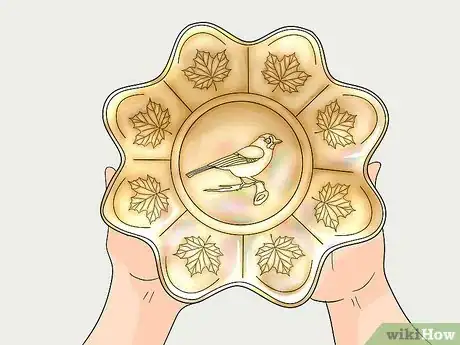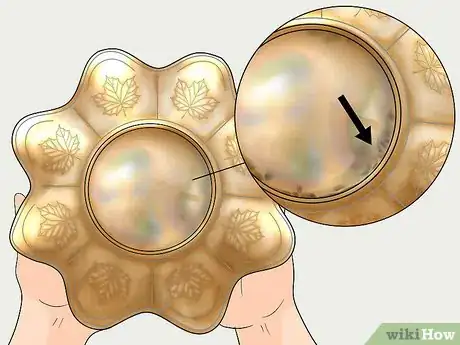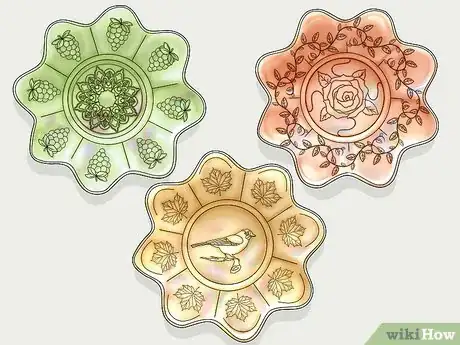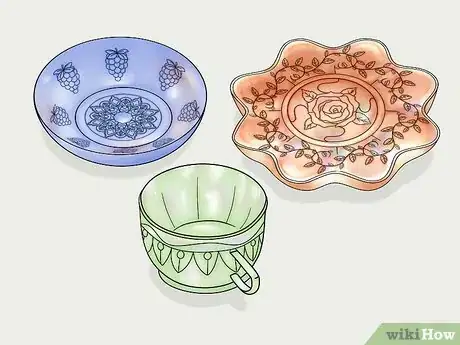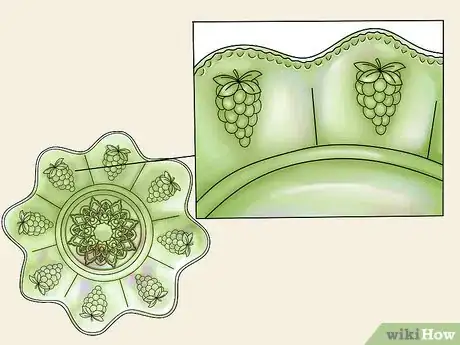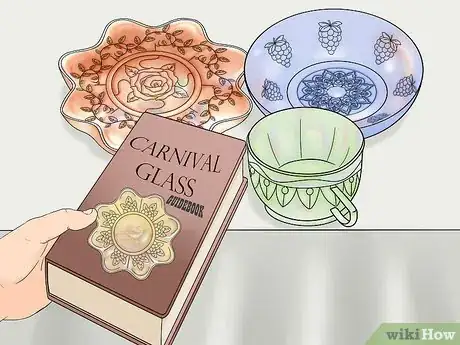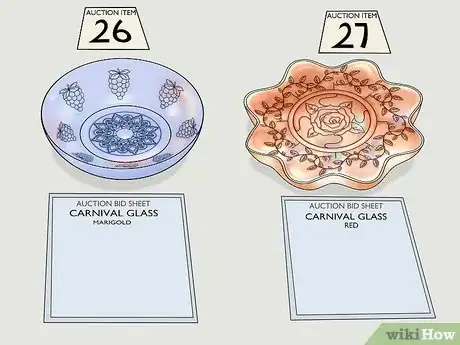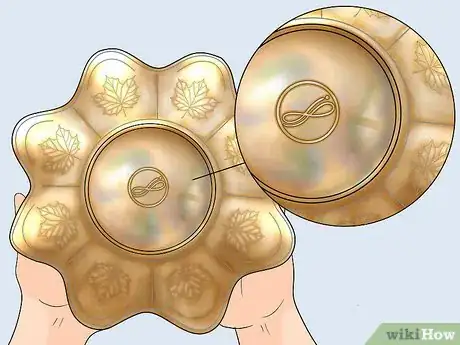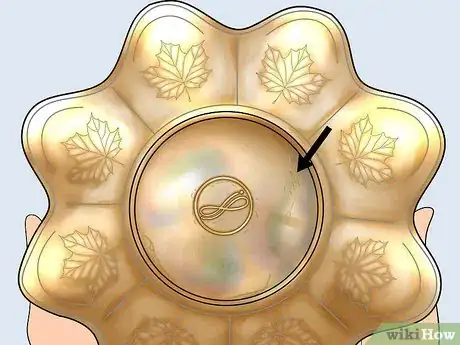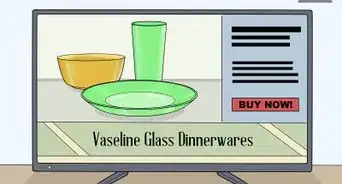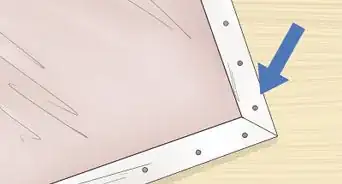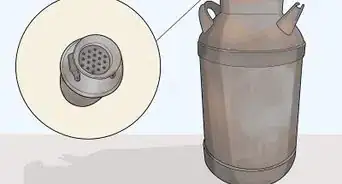This article was co-authored by wikiHow Staff. Our trained team of editors and researchers validate articles for accuracy and comprehensiveness. wikiHow's Content Management Team carefully monitors the work from our editorial staff to ensure that each article is backed by trusted research and meets our high quality standards.
This article has been viewed 51,261 times.
Learn more...
Carnival glass is one of the most popular antique collectibles—and one of the most complex to master. There are countless varieties of carnival glass out there, and even experts can be hard-pressed to say for certain who manufactured a piece or how to categorize its color under the iridescent sheen. The main things to look for in carnival glass are its color, its design, including shape and pattern, and its age. Once you have a handle on these aspects of a carnival glass piece, you’ll be able to keep records and sell the glass at auctions with ease.
Steps
Observing the Color and Sheen
-
1Hold up the glass in a well-lit space to check for a shimmer. Every piece made of carnival glass is reflective, with a characteristic shimmery veneer. The sheen of carnival glass has the multi-color, rainbow shimmer of of oil on water. Do this in a light area, as dark rooms can make the piece look like ordinary glass.[1]
- If the piece you are inspecting does not appear iridescent in light, then it cannot, by definition, be a piece of carnival glass.
-
2Look for an area without metal oxide, often the base. In order to determine what the color of the carnival glass is under the shimmer, you will have to find a section that lacks the oxide spray that creates the iridescent quality. In order to find a place like this, flip the piece over and check the raised base on the very bottom.
- Genuine antique carnival glass was sprayed by hand, so the base, where the worker would hold or rest the piece on a surface, often lacks the oily reflection.
Advertisement -
3Identify the color to see if the piece has a traditional carnival glass color. Some colors are simple to distinguish and identify, like the common, yellowish marigold or a simple red. However, experts on carnival glass have categorized almost 50 different colors that the vintage pieces can have. For an initial look at a piece, you only need to describe the basic color.
- You may want to compare pieces to get a more nuanced sense of the color.
- You can also consult one of the countless carnival glass guidebooks available for a list of colors.
Looking Closely at the Design
-
1Determine whether the piece is a bowl, plate, cup, vase, or another shape. Look at the piece and think about its depth, width, and possible purpose. You will have no problem identifying a cup or tumbler, but some have obscure purposes or are tough to distinguish. For instance, as a beginner, you may find the difference between a deep dish and a bowl to be confusing.
- If you find a piece you can’t figure out the purpose of, check a guidebook for examples of the many kinds of glassware that was used in the early 20th Century.
-
2Look for ridges and glass patterns on the edges. Many pieces of carnival glass, bowls and plates in particular, are rimmed with an uneven glass pattern. There are a few kinds of edges, with the most common being “ruffled,” or gently rounded protrusions, and “pie crust,” an unevenly crimped edge with 2 crimps of different sizes next to one another.
- Other edges include the “3 and 1,” which has 3 large crimps and one small one all around, “ribbon,” with small, tightly packed ruffles, “ice cream” edges, which have smooth, flat ruffles, and “sawtooth,” which has sharper points but the same low profile as the “ice cream” edges.
-
3Name the key aspects of the pattern on the piece. Most carnival glass has a decorative pattern on the exterior or interior of the piece. Figure out what is depicted on your own and think of a few words to describe it. Then, consult a guidebook or the internet for those keywords if you want to identify the exact pattern.[2]
- There are over 3000 recognized patterns, cast from molds, but don’t feel like you have to learn them all.
- Bowls are likely have one on the inner bottom, whereas cups and vases will have them on the side.
Determining the Quality and Age
-
1Establish the quality of the sheen for an easy estimate of the value. Each piece varies in the amount of shimmer it has. Often, more reflective and colorful pieces are considered to be higher quality, and sell for more at auction. If you have multiple pieces compare one to the others and see if you can establish the relative sheen of each one.
- There is no measure for sheen. Pieces that sell higher at auction are deemed beautiful, but the sheen cannot be described in factual terms other than “more reflective” or “less reflective,” often called “dull” or “weak” glass.
- The most reflective pieces are often called “electric” carnival glass.
-
2Check for a maker’s mark on the bottom. Some carnival glass pieces, though relatively few, have a mark that reveals the manufacturer. If you see one of these, look up pieces made by the manufacturer with the same color, shape, and pattern, and you will likely narrow down the date to a small range, or even a particular year.[3]
- On the other hand, if you can determine the age, you may be able to figure out who the manufacturer is, based on the manufacturers working in the decade you’ve narrowed the piece down to and the details of the piece.
- You can consult a list of maker’s marks in a guidebook, or at http://www.carnivalheaven.com/carnivalglass103/id76.htm.
-
3Examine the piece for scratches, wear, and tool marks. Older pieces are more likely to have a “rusty” appearance from the aging metal oxide, as well as to show certain tool marks that indicate the early years of carnival glass. Tool marks which won’t affect the value, often appear as deep scratches and grooves that don’t seem intentional.[4]
- Grooves on the bottom typically mean that the piece is from the early 1900s, making the piece more likely to be valuable.
- Make sure the tool mark isn’t a crack by holding the piece up to the light, which will reveal whether the mark goes all the way through the piece or not. Cracks will appear more jagged, as well.
-
4Compare the piece to a recognized list of fakes. Especially if the piece appears old and valuable, you should consult a list of fakes to make sure your piece is not one of the mass-produced fakes created at the height of the value of carnival glass.[5]
- You can find a widely-consulted list of fakes at http://www.ddoty.com/fakes.html.
- These lists won’t tell you for sure whether a piece is a fake or not, as not all fakes have been determined, but it will help.
